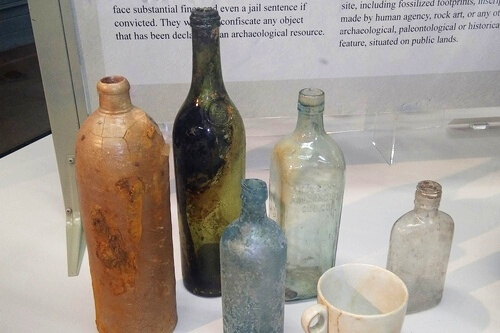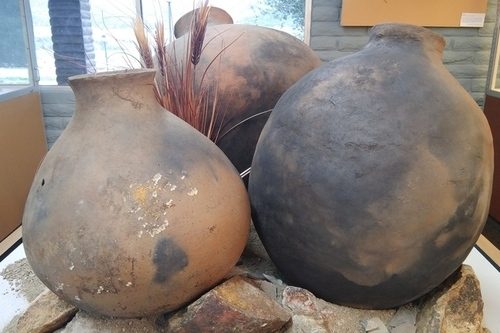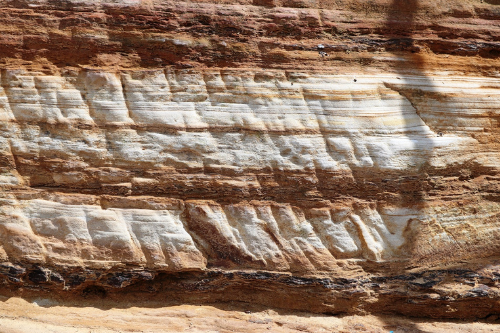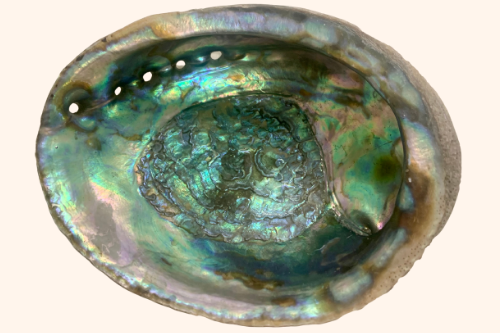
The Wonderful World of Animal Bone and Shell
The Wonderful World of… is a monthly blog focusing on some of the many themes, concepts, and sub-disciplines related to the fascinating world of Southern Californian archaeology.
What is Zooarchaeology?
Zooarchaeologists and osteoarchaeologists use animal remains to explore how past cultural environments used to look, what societies ate, and even to understand the movement of animals between different landscapes. The study of bones found at archaeological sites provides evidence about the time span, environment, health and diet, and population of prehistoric cultures.
Zooarchaeology is the branch of archaeology that studies faunal remains. Faunal remains are the physical remains (like bones and shell) that are left behind when an animal dies. Faunal remains are fragile, and their decomposition over time is likely. However, when they are found at an archaeology site, they can be incredibly useful in determining how past human cultures interacted with the animals that lived during a specific time period. Learning about how societies interacted with animals and their environment allows for a unique look into the past, which contributes to current and future scientific research.
Zooarchaeology in San Diego
Excerpt from The Wonderful World of Native Animals and Zooarchaeology
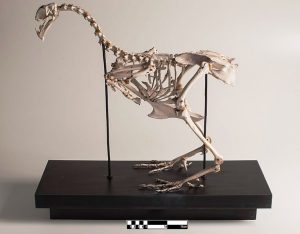
The San Diego Zooarchaeology Laboratory at the San Diego Natural History Museum was established in 2010 and houses more than 51,000 bird and 25,250 mammal specimens. These collections represent over 90% of worldwide bird species. More than 290 mammal species are also represented, and these collections continue to grow.
One of these species is the barnyard chicken. Zooarchaeologists Aharon Sasson and Susan Arter study skeletal remains from archaeological sites to learn about historic societies and cultures. Recently, they published a study presenting data about the first use of chickens for food in California during the 18th century. Before this study, not much was known about poultry production in North America. To learn about their findings and this project, watch the SDAC Living Room Lecture The First Chicken Burrito in Western North America: Avian Remains from the San Diego Royal Presidio.
Bone in San Diego Archaeology
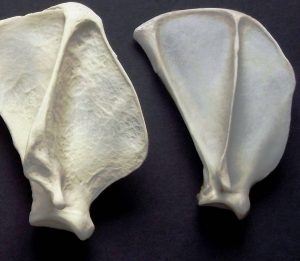
Photo: Malcom Lidbury
Bone is the least commonly found cultural resource in the San Diego region. Because these are organic materials, they eventually deteriorate over time. Animal bones were also often thrown into fire pits after their meat was consumed, leaving behind only charred remains that are sometimes found at archaeological sites. However, the bones have usually been reduced to charcoal, which makes their discovery, speciation, and study difficult.
This is a scapula or shoulder bone. After animals were consumed for food, their remains like fur or bones were often used for other purposes. A scapula could be a useful tool that may have been attached to wood and used for digging as a hoe.
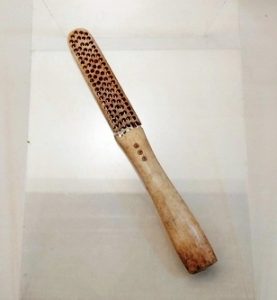
Hunter-gatherer societies used bones to make tools. Bone tools have been used throughout human existence to make many different types of tools that many modern tools are still modeled after today. They are softer than stone and harder than wood, making them resilient materials useful for humans. Organic materials like bone are fragile to climate, soil conditions, and land use and they often deteriorate before their discovery.
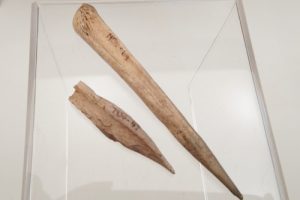
This bone toothbrush is from an archaeological site where working class people lived during the late Victorian period (circa 1880-1915).
This bone awl was made during the Late Prehistoric Tradition (3,000 – 300 years ago) and would have been used to poke holes in things like leather to make clothing and basketry. The modern version of this tool would be a sewing needle. The sharp, pointed spike helps pierce and mark a variety of materials.
Shell in San Diego Archaeology
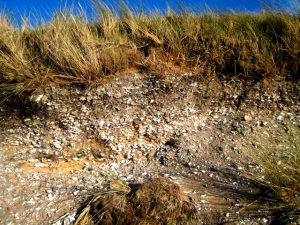
Photo: Martyn Gorman
Like bones, shell remains are also incredibly useful in archaeology, and their remains are studied by archaeologists to learn how past human cultures interacted with the animals that existed around them. Shell middens are a deposit of debris, or what we more commonly think of as garbage pits. Their collection may tell archaeologists more about the humans that had previously occupied a site. A shell midden helps archaeologists uncover what types of shellfish were being consumed. Using carbon-14 dating, sites can be identified with a specific date. Dating shell midden is useful because it helps to date the other cultural resources found around a site that may have been previously undated.
Donax shellfish are commonly found among the shell middens in the San Diego area. By studying ecological changes in the local environment, archaeologists know that a site where these types of shell are found must date after 4,000 years before present. This species of shell did not become prevalent in San Diego until about 4,000 years ago, when the water warmed.
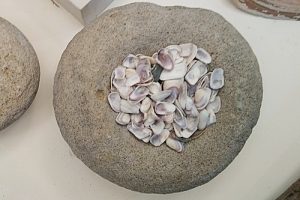
The stone bowl holding the Donax shells is from the La Jolla Tradition dating 7,500 – 3,000 years ago.
Shellfish have been popular for food consumption throughout time. Shellfish remains found at archaeological sites in San Diego help determine the age of the site using carbon-14 technology. Once a shellfish dies, the present carbon-14 atoms begin to decay. Carbon-14 has a half-life of 5,730 years, so there would be half as many carbon-14 atoms present in the shell after 5,730 years. By counting how many carbon-14 atoms remain, it can be determined when the shellfish was alive and provide dating information for a specific site.
Carbon-14 Dating
Excerpt from Dig Deeper: How old is it? Absolute Dating
Organic artifacts such as bone or shell absorb a certain amount of carbon in their lifetime. When organic materials die, the number of carbon-14 begins to decline. The rate of decay can measure the remaining Carbon-14 giving archaeologists a more exact date.
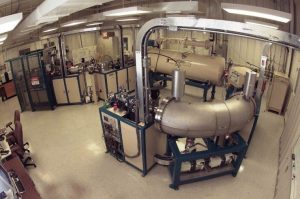
Another form of absolute dating is called Carbon-14 dating. This type of dating can be used to date organic artifacts. An organic artifact is an artifact that once was living, like bone or shell. Carbon is an element that is absorbed by all living things during their lifetime. A regular carbon element has an atomic weight of 12. To break it down even further, carbon is made of six protons and six neutrons. (To learn more about atoms, protons, and neutrons watch this video on YouTube.)
Carbon-14 is different from carbon in that it is an isotope of carbon. Chemical elements have one or more isotopes and these are defined as each of two or more forms of the same element that contain equal numbers of protons but different numbers of neutrons. Carbon-14 has two extra neutrons, giving it an atomic weight of 14 with six protons and eight neutrons.
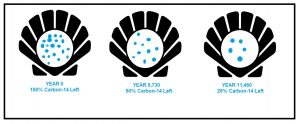
Carbon is absorbed by all living things. When a plant or animal dies, the number of carbon-14 atoms start to decline. Scientists and archaeologists know the rate of decay, which helps them to measure the remaining carbon-14 in the object and determine how old it is. Carbon-14 dating can be used for organic objects that are 500 to about 50,000 years old.
After the shellfish dies, the carbon-14 atoms begin to decay. Carbon-14 has a half-life of 5,730 years, so there would be half as many carbon-14 atoms present in the shell after 5,730 years. By counting how many carbon-14 atoms remain, it can be determined when the shellfish was alive.
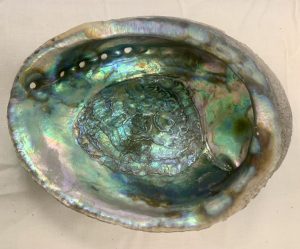
Abalone shells can be found on the California coast and would have been a staple in prehistoric California coastal diets. An ecofact like this shell is an archaeological find that was used, but not manufactured, by humans. An abalone shell is significant to archaeologists because it can tell a story about past diets and meal preparations.
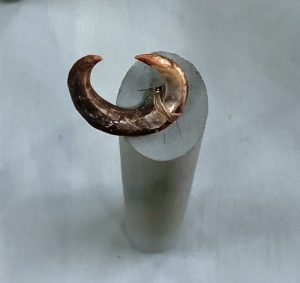
Similar to bone, shell remains were also used to make tools once their meat was consumed. This is a fishhook made from shell. Shell fishhooks have been found at archaeological sites around the world.
by Jessica McPheters, Collections Manager


